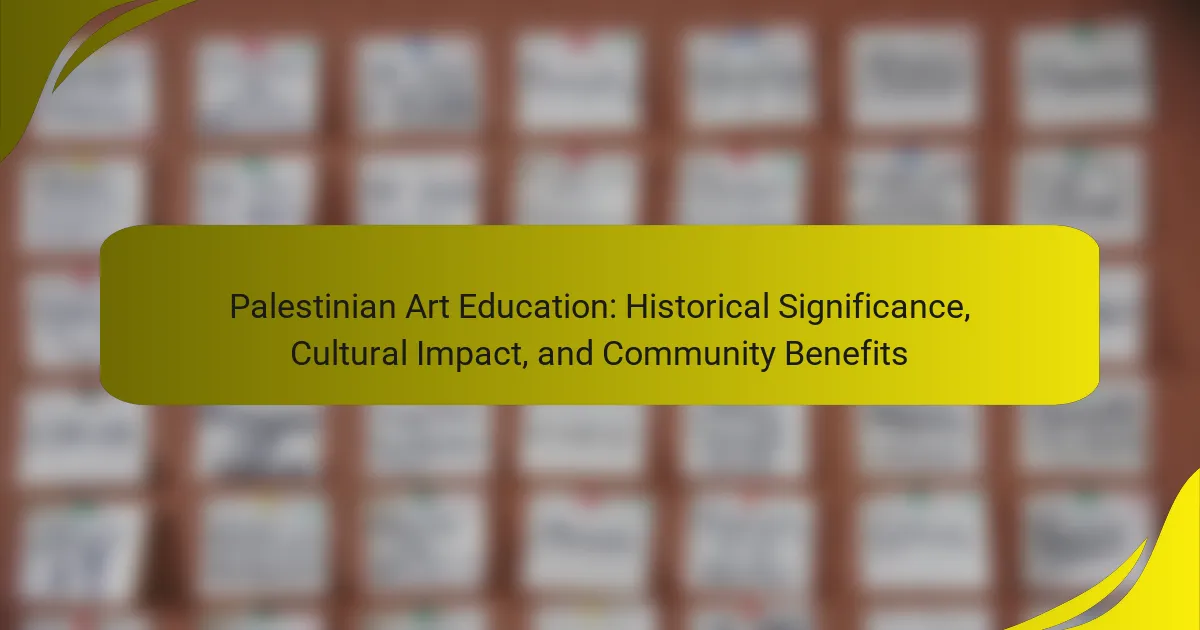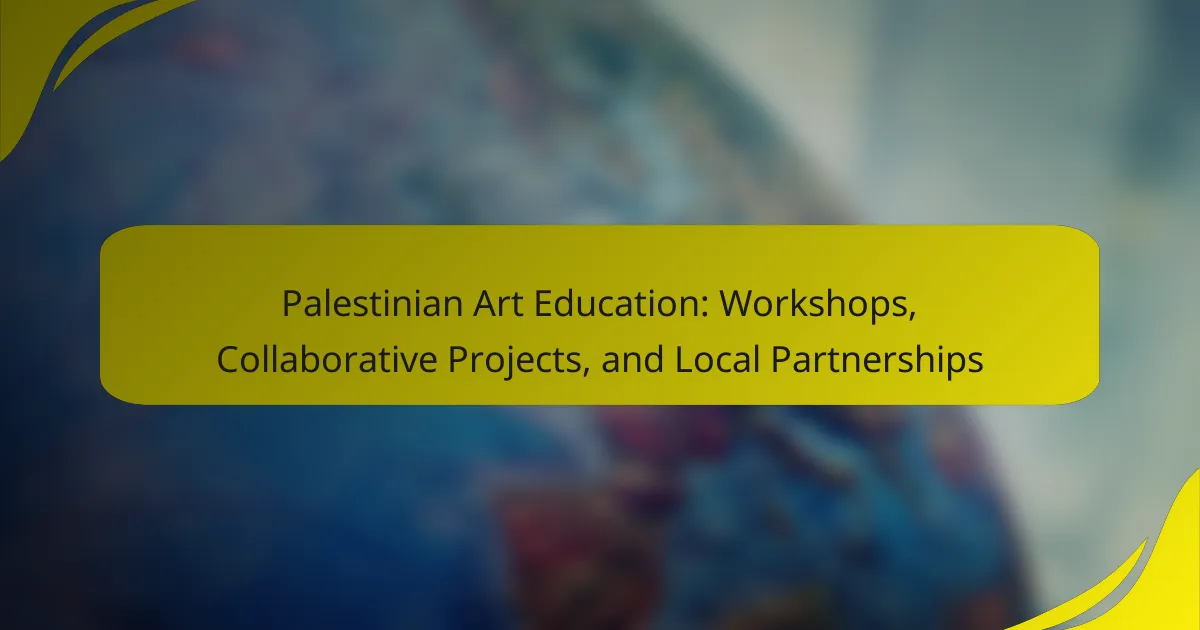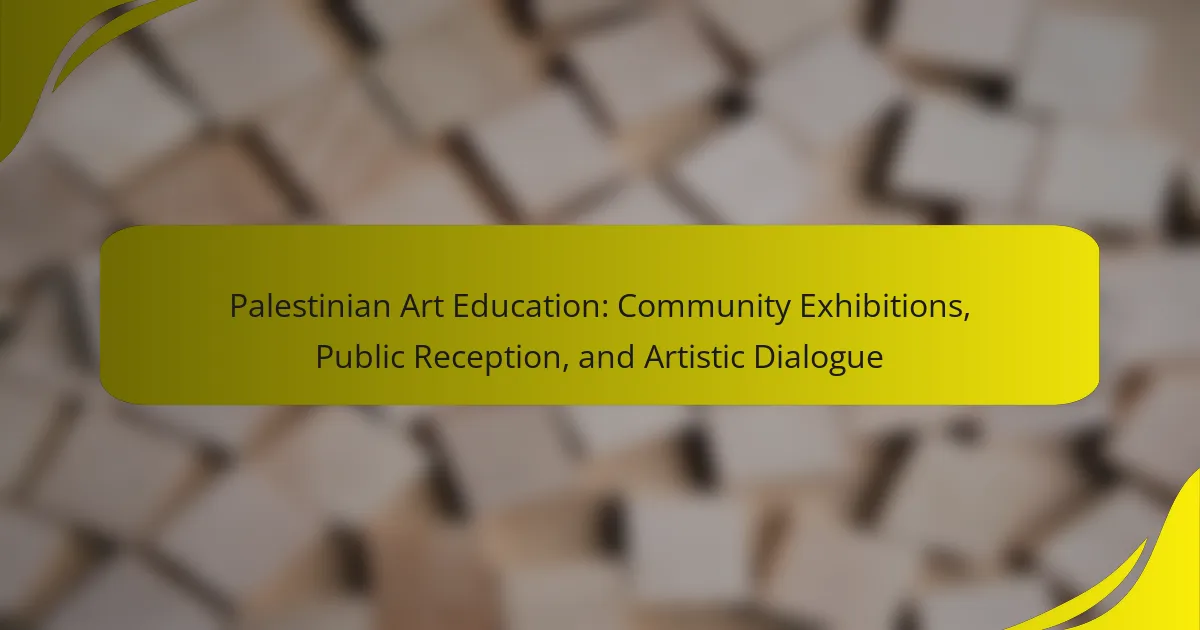Palestinian Art Education encompasses the teaching and practice of various forms of artistic expression, including visual arts, music, and performance, within Palestinian communities. This educational framework aims to nurture creativity and cultural identity among Palestinian youth while addressing traditional themes and contemporary societal issues. Institutions such as universities and community centers play a crucial role in delivering programs that promote cross-cultural exchanges and collaborations with international artists. The article highlights the significance of Palestinian Art Education in fostering dialogue, resilience, and social advocacy, while also emphasizing its growing recognition in the global art landscape. Through these artistic initiatives, Palestinian narratives gain visibility and contribute to a broader understanding of cultural identity and social commentary.
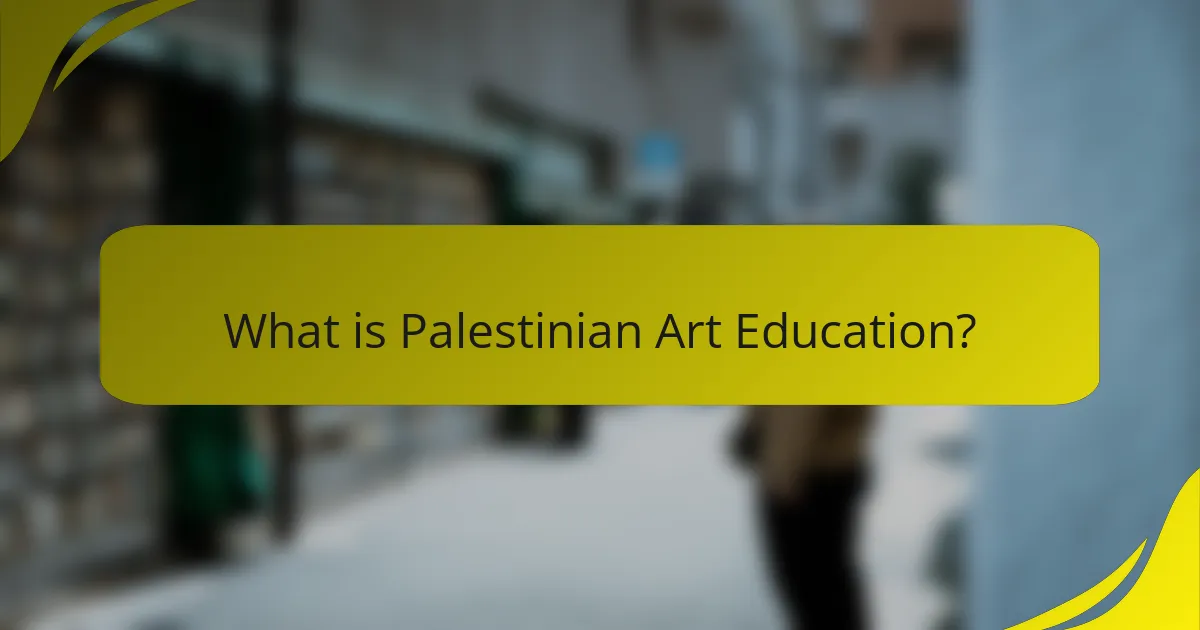
What is Palestinian Art Education?
Palestinian Art Education refers to the teaching and practice of art within Palestinian communities. It encompasses various forms of artistic expression, including visual arts, music, and performance. The education system aims to foster creativity and cultural identity among Palestinian youth. It often incorporates traditional themes and contemporary issues relevant to Palestinian society. Institutions like universities and community centers play a vital role in this educational framework. Programs may also include workshops and collaborations with international artists. This approach promotes cross-cultural exchanges and global perspectives in art. Palestinian Art Education is crucial for preserving cultural heritage and addressing social challenges through artistic means.
How does Palestinian Art Education reflect cultural identity?
Palestinian Art Education reflects cultural identity by incorporating traditional themes and narratives. It emphasizes the historical experiences and struggles of the Palestinian people. Art education programs often focus on local heritage, folklore, and social issues. This approach fosters a sense of belonging and community among students. Workshops and exhibitions showcase Palestinian artists and their perspectives. The integration of cultural symbols in artworks reinforces national identity. Research by the Institute for Palestine Studies highlights the role of art in cultural preservation. These educational practices contribute to a collective memory and resilience among Palestinians.
What historical influences shape Palestinian Art Education?
Palestinian Art Education is shaped by various historical influences. The Ottoman Empire’s rule introduced formal art training and institutions. British Mandate policies further impacted the educational landscape, emphasizing Western art techniques. The 1948 Nakba led to a diaspora that infused diverse cultural influences into Palestinian art. Post-1967 occupation saw increased emphasis on national identity in artistic expression. International collaborations and exhibitions have also played a significant role in shaping contemporary practices. The evolution of Palestinian art education reflects these complex historical contexts and cultural exchanges.
How do local traditions impact artistic practices in Palestinian Art Education?
Local traditions significantly shape artistic practices in Palestinian Art Education. These traditions provide a cultural framework that informs the themes and techniques used by artists. For instance, traditional crafts such as embroidery and pottery are integrated into contemporary art curricula. This integration preserves cultural heritage while encouraging innovation. Furthermore, local narratives and historical contexts influence the subject matter of artworks. Artists often draw inspiration from folklore and local history, making their work resonate with communal identity. Research indicates that these practices foster a sense of belonging among students. By engaging with local traditions, Palestinian artists can express their unique cultural perspectives on global platforms.
What are the main objectives of Palestinian Art Education?
The main objectives of Palestinian Art Education include fostering cultural identity, promoting artistic expression, and enhancing critical thinking skills. Palestinian Art Education aims to empower students through creative practices. It encourages the exploration of heritage and social issues through art. The curriculum often integrates local history and contemporary themes. This approach helps students connect with their identity and community. Additionally, it promotes dialogue and understanding across cultures. Art education in Palestine often seeks to build resilience among youth. It provides a platform for addressing political and social challenges through creativity.
How does Palestinian Art Education promote social awareness?
Palestinian art education promotes social awareness by integrating cultural history and contemporary issues into its curriculum. This approach encourages students to explore themes of identity, resistance, and community. Through artistic expression, learners engage with social justice topics relevant to their society. Workshops and projects often highlight local narratives and struggles. Collaborative art initiatives foster dialogue among diverse groups. Exhibitions showcase student work, raising public consciousness about Palestinian experiences. Research indicates that art education can enhance critical thinking and empathy in students. This educational framework actively contributes to a more informed and socially aware community.
In what ways does it encourage creative expression among students?
Palestinian art education encourages creative expression among students by integrating diverse cultural perspectives into the curriculum. It allows students to explore their identity through various artistic mediums. Collaborative projects foster teamwork and innovation among peers. Exposure to global artistic influences broadens their creative horizons. Workshops with professional artists inspire unique personal expression. Art exhibitions provide platforms for showcasing student work, validating their creativity. Community engagement through art initiatives enhances their social awareness and responsibility. This multifaceted approach cultivates a vibrant artistic environment, promoting self-discovery and expression.
What role does cross-cultural exchange play in Palestinian Art Education?
Cross-cultural exchange plays a significant role in Palestinian Art Education. It enhances creativity and broadens perspectives among Palestinian artists and students. This exchange facilitates the sharing of diverse artistic techniques and cultural narratives. Collaborative projects with international artists enrich the local art scene. They provide opportunities for dialogue and mutual understanding. Exposure to global art movements influences Palestinian art practices. Research shows that such exchanges foster innovation and cultural resilience. Programs like the “Art and Cultural Exchange” initiative demonstrate the positive impact on artistic development.
How do international collaborations enhance artistic learning?
International collaborations enhance artistic learning by providing diverse perspectives and techniques. These collaborations expose artists to different cultural practices and artistic traditions. They encourage the exchange of ideas and foster innovation in artistic expression. Collaborative projects often lead to the creation of new works that blend various styles and techniques. Research shows that such interactions can improve creativity and critical thinking skills. For example, a study published in the “Journal of Arts Education” found that collaboration increases engagement and motivation among artists. This enriched learning environment ultimately leads to a more comprehensive understanding of art.
What are the benefits of cultural exchange programs for Palestinian artists?
Cultural exchange programs provide significant benefits for Palestinian artists. These programs enhance artistic skills through exposure to diverse techniques and practices. They foster collaboration with international artists, promoting creative partnerships. Cultural exchange encourages the sharing of Palestinian narratives on global platforms. Artists gain access to new audiences and markets, increasing visibility for their work. Networking opportunities arise, leading to potential exhibitions and collaborations. Such programs also contribute to cultural diplomacy and understanding. They help in preserving and promoting Palestinian heritage through art.
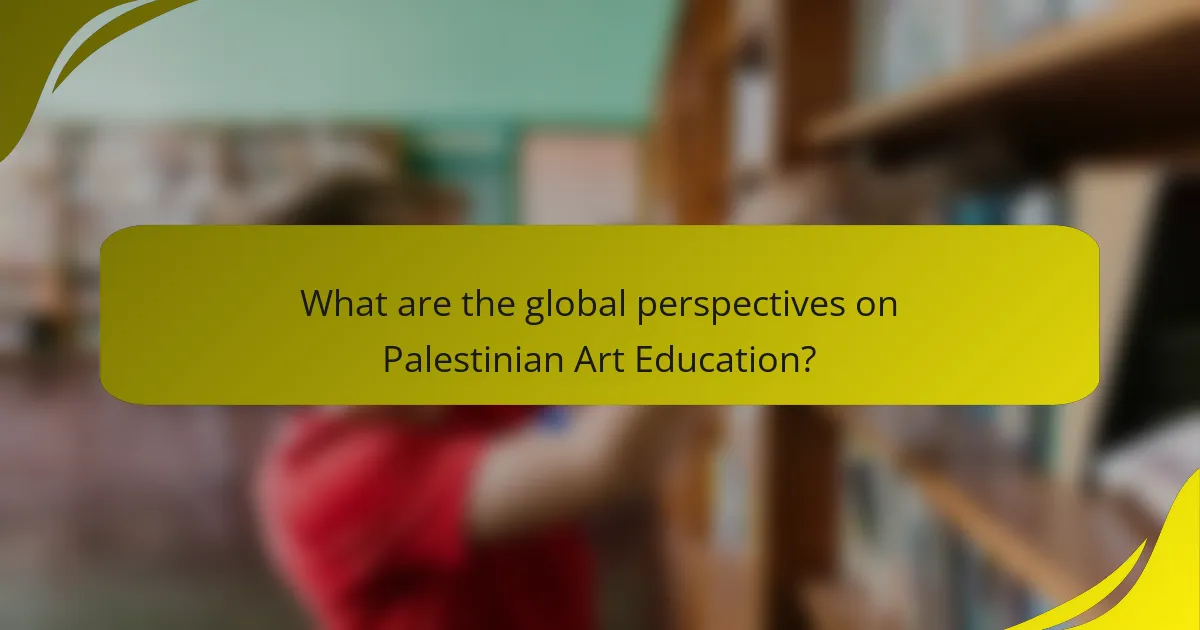
What are the global perspectives on Palestinian Art Education?
Global perspectives on Palestinian Art Education emphasize its role in cultural expression and identity. Various international institutions recognize its significance in fostering dialogue and understanding. Art education in Palestine often addresses themes of resistance and resilience. Programs aim to empower youth through artistic skills. Collaborations with global artists enhance exposure and exchange. The impact of socio-political contexts is a common discussion point. Many view Palestinian art as a medium for advocacy and awareness. Overall, there is a growing appreciation for its contributions to global art discourse.
How is Palestinian Art Education perceived internationally?
Palestinian Art Education is perceived internationally as a vital expression of cultural identity and resilience. It showcases the socio-political context of Palestine through various artistic mediums. Internationally, it is recognized for its unique blend of traditional and contemporary influences. Critics and scholars often highlight its role in fostering dialogue about social justice and human rights. Events such as exhibitions and workshops have gained attention, promoting Palestinian artists on global platforms. Initiatives by organizations like the Al-Quds University Art Department amplify this perception. The art produced often reflects themes of displacement and hope, resonating with audiences worldwide. Overall, Palestinian Art Education is viewed as a significant contributor to global artistic discourse.
What are the main challenges faced by Palestinian artists abroad?
Palestinian artists abroad face several significant challenges. Limited access to funding and resources hampers their ability to create and showcase work. Cultural misrepresentation often leads to stereotypes that overshadow their artistic expression. Political restrictions can affect their mobility and participation in international exhibitions. Additionally, language barriers may hinder effective communication and collaboration with global audiences. The lack of institutional support from both Palestinian and host countries further complicates their professional development. These challenges collectively impact the visibility and recognition of Palestinian artists in the global art scene.
How do global art movements influence Palestinian artistic practices?
Global art movements significantly influence Palestinian artistic practices by introducing new styles and concepts. These movements provide a framework for Palestinian artists to express their cultural identity. For instance, contemporary art movements like surrealism and postmodernism have inspired local artists to explore themes of displacement and resistance. Artists often incorporate global techniques while addressing local narratives. This blending creates a unique artistic voice that resonates both locally and internationally. The influence of global art is evident in exhibitions and collaborations that showcase Palestinian art on global platforms. Such interactions facilitate cross-cultural dialogue and enhance visibility for Palestinian artists.
What impact do global perspectives have on local art education?
Global perspectives significantly enhance local art education by introducing diverse methodologies and cultural contexts. They foster creativity and innovation in teaching practices. Exposure to international art trends broadens students’ understanding of artistic expressions. This integration encourages critical thinking and cross-cultural dialogue among students. For instance, programs that connect Palestinian artists with global communities enrich local curricula. Such collaborations often lead to the incorporation of varied artistic techniques and philosophies. Research indicates that students exposed to global art perspectives exhibit increased engagement and motivation. Overall, global influences cultivate a more comprehensive and inclusive art education framework.
How do international standards shape Palestinian art curricula?
International standards shape Palestinian art curricula by providing guidelines for quality and inclusivity. These standards influence curriculum development by emphasizing critical thinking and creativity. They encourage the integration of diverse artistic traditions and contemporary practices. Palestinian educators adapt these standards to reflect local cultural contexts. This adaptation fosters a unique artistic identity while maintaining international relevance. Research shows that adherence to such standards enhances educational outcomes. For instance, the UNESCO Framework for Cultural Education supports the integration of global perspectives in local curricula. This framework helps Palestinian artists and educators connect with broader artistic dialogues.
What role do global art institutions play in supporting Palestinian art?
Global art institutions play a significant role in supporting Palestinian art. They provide platforms for Palestinian artists to showcase their work internationally. Institutions like the Tate Modern and the Guggenheim have hosted exhibitions featuring Palestinian artists. These exhibitions raise awareness of Palestinian culture and issues. Additionally, global art institutions often collaborate with local Palestinian organizations. This collaboration helps in the development of art education programs. Financial support from these institutions can also aid Palestinian artists and art initiatives. Such efforts contribute to the visibility and appreciation of Palestinian art on a global scale.
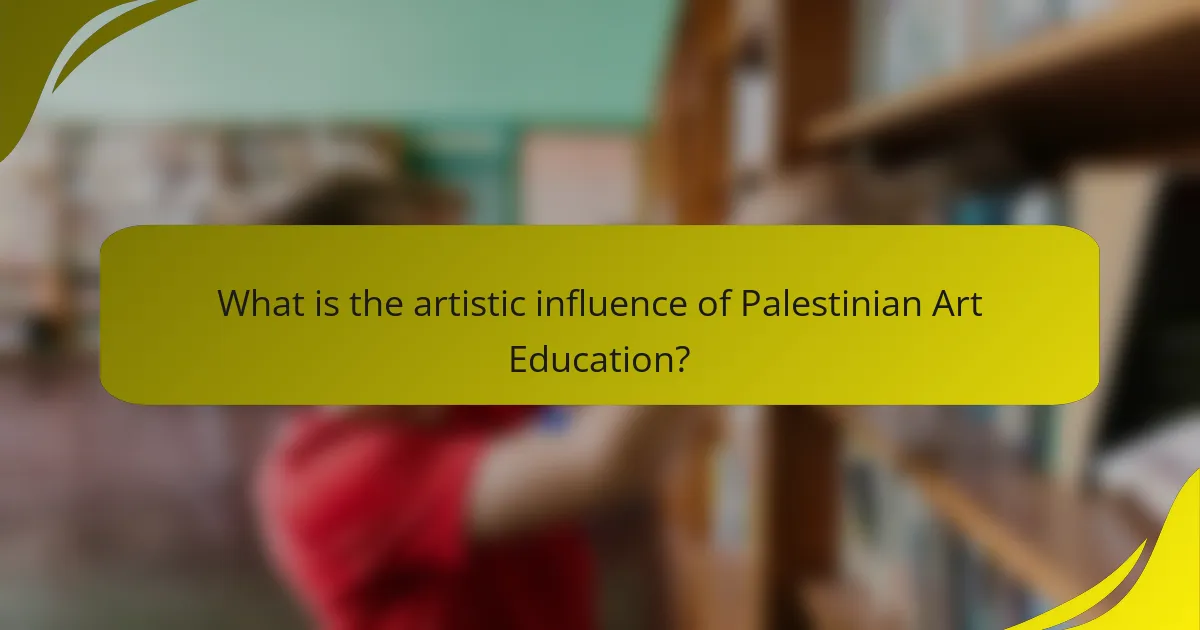
What is the artistic influence of Palestinian Art Education?
Palestinian Art Education significantly influences both local and international artistic landscapes. It fosters a unique blend of cultural identity and social commentary. Artists educated in this environment often respond to political and social issues through their work. This artistic approach has gained recognition globally, resonating with audiences beyond Palestine. The emphasis on traditional techniques alongside contemporary practices creates a rich dialogue in art. Collaborations with international artists further enhance this influence. Institutions like the International Academy of Art Palestine promote cross-cultural exchanges. These exchanges contribute to a broader understanding of Palestinian narratives in the global art scene.
How does Palestinian Art Education inspire new artistic movements?
Palestinian Art Education inspires new artistic movements through its emphasis on cultural identity and social issues. This education integrates traditional techniques with contemporary themes. It encourages artists to explore narratives of resistance and resilience. Workshops and community projects foster collaboration among diverse artists. Notable examples include the work of artists like Emily Jacir and Larissa Sansour. Their art reflects personal and collective experiences shaped by the Palestinian context. This unique perspective influences global art discussions. It creates a platform for dialogue on identity and politics.
What are the notable trends emerging from Palestinian artists?
Emerging trends from Palestinian artists include a focus on identity and heritage. Many artists explore themes of displacement and resilience. This reflects the socio-political context of Palestine. Artists are increasingly using mixed media to convey complex narratives. Digital art is gaining popularity among younger generations. Collaborations with international artists are also becoming common. Social media platforms serve as vital tools for exposure and engagement. These trends highlight a dynamic and evolving art scene.
How does the political landscape influence artistic expression?
The political landscape significantly influences artistic expression. Political events often shape the themes and messages in art. Artists may respond to oppression, conflict, or social issues through their work. For instance, during times of war, art can serve as a form of protest or a means of documenting experiences. In the context of Palestinian art, political struggles are frequently reflected in visual works and performances. Historical events, such as the Nakba, have inspired artists to convey their narratives through various mediums. Additionally, censorship and restrictions imposed by political regimes can limit artistic freedom. This creates a dynamic where artists may adapt their expression to navigate these challenges. Overall, the interplay between politics and art is evident in the ways artists respond to their environments.
What are the key challenges in Palestinian Art Education?
Key challenges in Palestinian Art Education include limited resources, political instability, and restricted access to art materials. Many institutions struggle with inadequate funding, impacting curriculum development. Political conflict often disrupts educational continuity and safety. Furthermore, restrictions on movement hinder access to workshops and exhibitions. Cultural censorship also limits artistic expression. These factors collectively create a challenging environment for art educators and students in Palestine.
How do political and economic factors affect art education in Palestine?
Political and economic factors significantly affect art education in Palestine. The ongoing conflict and political instability limit resources allocated to education. Schools often lack funding for art programs and materials. Economic hardship leads to reduced enrollment in art courses. Many students prioritize vocational training over artistic pursuits due to job market pressures. Restrictions on movement hinder access to cultural institutions and workshops. Additionally, political censorship can stifle artistic expression in educational settings. These factors collectively create an environment where art education struggles to thrive.
What resources are available to overcome these challenges?
Resources available to overcome challenges in Palestinian art education include funding from international organizations. These organizations often provide grants for educational programs. Collaborative projects with global art institutions can enhance resources and expertise. Workshops led by experienced artists can offer practical skills and techniques. Online platforms for virtual learning can expand access to diverse art education. Community art initiatives can promote local talent and foster engagement. Partnerships with NGOs can facilitate cultural exchanges and broaden perspectives. Lastly, advocacy for policy support can help secure long-term funding and resources.
What best practices can enhance Palestinian Art Education?
Integrating community engagement into Palestinian art education enhances its effectiveness. Community involvement fosters a sense of belonging and relevance among students. Collaborative projects with local artists can provide real-world experience. Incorporating diverse artistic styles can broaden students’ perspectives. Access to technology and resources can expand creative possibilities. Establishing partnerships with international art institutions can facilitate knowledge exchange. Regular workshops and exhibitions can showcase student work and boost confidence. Curriculum development should include historical and cultural context to enrich learning.
How can community involvement improve art education outcomes?
Community involvement can significantly improve art education outcomes by enhancing resources and support for students. Engaged communities can provide funding, materials, and venues for art programs. This support allows for more comprehensive art curricula that can include diverse artistic perspectives. Community members can also serve as mentors, offering students real-world insights and guidance. Studies show that community involvement fosters a sense of belonging among students, which can enhance their motivation and engagement. For example, programs that incorporate local artists have been shown to increase student creativity and confidence. Furthermore, collaboration with local organizations can lead to exhibitions and public art projects, showcasing student work and validating their efforts. This visibility can inspire other students and strengthen community ties. Overall, active community participation creates a richer, more supportive environment for art education.
What strategies can educators implement to foster creativity?
Educators can implement project-based learning to foster creativity. This approach allows students to engage in hands-on projects that require critical thinking and problem-solving. Collaborative group work enhances creative thinking by encouraging diverse perspectives. Incorporating art and visual thinking techniques stimulates imagination and expression. Providing open-ended assignments gives students the freedom to explore their interests. Utilizing technology tools can inspire innovative solutions and creative presentations. Regularly integrating feedback sessions helps refine ideas and promotes a growth mindset. Research shows that these strategies effectively enhance creative skills in educational settings.
Palestinian Art Education is the framework for teaching and practicing art within Palestinian communities, encompassing visual arts, music, and performance to foster creativity and cultural identity. The article explores how this education reflects cultural identity through traditional themes and contemporary issues, shaped by historical influences and local traditions. It discusses the objectives of promoting social awareness and creative expression, the role of cross-cultural exchanges and international collaborations, and the global perspectives on Palestinian art. Additionally, it addresses challenges faced by artists and educators, as well as best practices to enhance art education outcomes.
